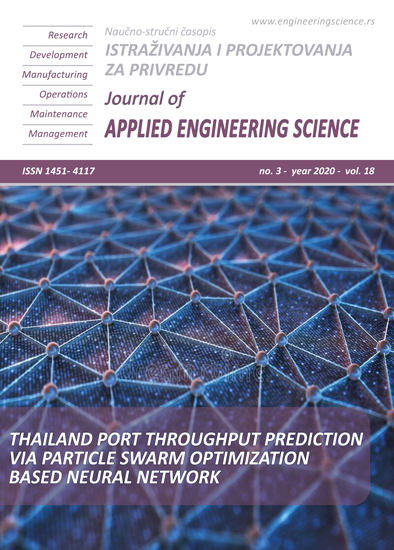MODELING OF INFLUENCE OF MICROBIOLOGICAL AGGRESSIVE MEDIA ON CORROSION OF CEMENT STONE
Abstract
Due to the complex and constantly changing global environmental situation, the study of the resistance of mineral binder-based building composites to the effect of the metabolism products of microscopic organisms seems particularly relevant. Taking into account the nature of the effect of bacteria and mycelial fungi on cement stone, a method of evaluating the resistance on the basis of modeling by replacing the real development of colonies of microorganisms with chemically aggressive aqueous solutions of their life products is proposed. It is allowed to study the current processes of phase transformations, as well as changes of operational parameters in the form of regression dependencies.
References
[2] Cwalina B., Dzierżewicz Z.; Korozja biologiczna konstrukcji żelbetowych (Biological corrosion of reinforced concrete constructions). XXI Polish Conference „Warsztat Pracy Projektanta Konstrukcji”, Szczyrk, T.1, Wyd. PZITB, O/Gliwice, 2006; p. 79-108 (in Polish)
[3] Berdoudi, S., Hebhoub, H. and Djebien, R. Valorization and recycling of quarries waste as an addition in cement // Journal of Applied Engineering Science 15(2017)2, 420, 122 – 127 doi:10.5937/jaes15-12743
[4] Perego P., Fabiano B.; Corrosion, microbial. In: Flickinger M.C., Drew S.W. (Eds) Encyclopedia of Bioprocess Technology: Fermentation, Biocatalysis and Bio-separation. John Wiley & Sons, Inc., New York, 1999; p. 717-729.
[5] Cwalina B., Zyska B.;Mineralne materiały budowlane – kamień, beton, cegła, zaprawy budowlane, szkło. W: Mikrobiologia Materiałَw. (Mineral building materials – stone, concrete, mortars, glass. In: Microbiology of Materials.) Zyska B., Żakowska Z. (Red.), Wyd. Politechniki Łَdzkiej, Łَdź, 2005, s. 377-412. (in Polish).
[6] Erofeev, V. Frame Construction Composites for Buildings and Structures in Aggressive Environments. ProcediaEngineering. 2016. 165. Pp. 1444-1447. doi: 10.1016/j.proeng.2016.11.877.
[7] Vincke E., Boon N., Verstraete W.; Analysis of the microbial communities on corroded concrete sewer pipes – a case study. Applied Microbiology and Biotechnology, 57, 2001; p. 776-785.
[8] Cwalina B.; Korozja kamienia i betonu wzbudzona przez drobnoustroje (The stone and concrete corrosion influenced by microorganisms). Ochrona przed Korozją, 1, 2004; p. 17-23 (in Polish).
[9] Roberts D.J., Nica D., Zuo G., Davis J.L.; Quantifying microbially induced deterioration of concrete: Initial studies. International Biodeterioration and Biodegradation, 49, 2002; p. 227-234.
[10] Erofeev, V., Rodin, A., Rodina, N., Kalashnikov, V., Irina, E. Biocidal Binders for the Concretes of Unerground Constructions. ProcediaEngineering. 2016. 165. Pp. 1448-1454. doi: 10.1016/j.proeng.2016.11.878.
[11] Eriksen K.; Thaumasite attack on concrete at Marbjerg Waterworks. Cement and Concrete Composites, 25, 2003; p. 1147-1150.
[12] Jana D., Lewis R.A.; Acid attack in a concrete sewer pipe – a petrographic and chemical investigation. Proc. 27th Int. Conf. Cement Microscopy, ICMA, Victoria, Canada, 2005.
[13] Ważny J.; The influence of wood-destroying fungi on concrete. In: Oxley T.A., Becker G., Allsopp D. (Eds) Biodeterioration. Pitman Publ. Ltd., London, 1980; p. 59-62.
[14] Erofeev, V., Dergunova, A., Piksaikina, A., Bogatov, A., Kablov, E., Startsev, O., Matvievskiy, A. The Effectiveness of Materials Different with Regard to Increasing the Durability. MATEC WebofConferences. 2016. doi: 73,04021.10.1051/matecconf/20167304021.

